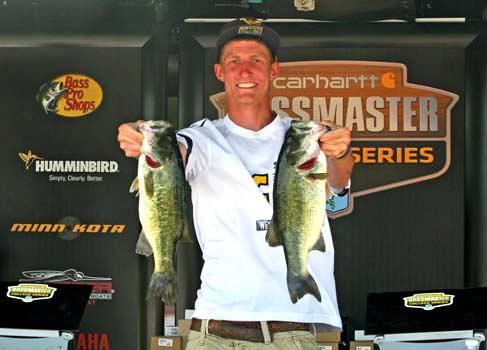Edward Rude III arrived in La Crosse, Wis., by way
of a 16-hour drive from his hometown of Falling Waters, W.Va. He was in
an unfamiliar town to fish in a tournament on an even more foreign body
of water. It was the Mississippi River, a complex fishery to understand
for an angler from the mountains of West Virginia.
Rude, 19, didn’t let the
river’s daunting size and complex maze of backwaters confuse him for
long. The West Virginia University business student found a game-winning
strategy and took first place in the Carhartt College Series Midwest
Super Regional. His two-day total was 31 pounds, 1 ounce and just good
enough to shut out the 30-10 effort staged by Eric Tessmer and Korey
Sybrant of St. Cloud University.
Rude’s winning strategy
and his chosen area dumbfounded anglers from the Midwest schools. The
prevailing pattern revolved around running-and-gunning for postspawn
bass on the move from backwater spawning areas. That was the game plan
for St. Cloud University and a Winona State University team that
finished in third place.
Rude was all alone in his
area because it simply didn’t make sense to be there for anybody but an
out-of-towner. His obscure area was located up the Black River in a
small no-name bay. Its bare bank sloped at a 45-degree angle into a
25-foot channel. There was nothing fishy for its entire run of 300
yards.
But the name of the game
was the presence of baitfish. Rude saw them breaking the surface upon
entering the area during a blind, random stop there on the final
practice day.
Being on a strange body
of water pointed Rude to a familiar choice in his tacklebox. With little
else to go on, he tied it on and went to work.
“A jerkbait is definitely a confidence lure for
me,†he said. “So I threw it just for the confidence of knowing that if I
could get something going on it, then I would be fine.â€
The pattern came together quickly on the first
tournament day. A limit weighing 15-7 was swimming inside his livewell
within 45 minutes of arrival time.
“There was just so much food in there, the fish didn’t have any choice
but to stay and feed,†he said. “Actually they had no reason to leave.â€
During
the short stay, Rude boated a largemouth weighing 4-5 that eventually
would tie for the Carhartt Big Bass Award. Following it to the boat were
two more fish of the same size. Striped bass were part of the surface
feeding frenzy that would erupt on occasion.
Certain the bass would
stay with the bait, he vacated the area at 8:30 a.m. Back at the
weigh-in, Rude held on to second place with a 4-ounce deficit behind the
15-11 weight of leaders Tessmer and Sybrant.
On the final day, Rude
arrived at the spot within minutes of the 5:30 a.m. takeoff time.
Another limit was on board by 6:15 a.m. The bait hadn’t diminished in
quantity, and the bass were showing themselves again during their
feeding attacks.
Rude stayed for the
remainder of the day to upgrade his catch. The effort paid off with a
15-10 catch that measured up as the biggest sack of the tournament.
The confidence lure was a No. 8 clown colored
Rapala X-Rap. He fished the jerkbait on 15-Seaguar InvizX that was
spooled to Quantum bait cast reels. He fished the combo on a variety of
medium-heavy action rods.
His technique was as simple as the area itself. All he did was cast the rig into the mix of bass and bait for the hookups.
“It just feels awesome to finally win one of these, because it’s been a goal of mine,†said Rude.
Tessmer
and Sybrant fished a backwater area featuring a mix of isolated
boulders and stumps scattered along the shoreline. The setup is common
in river pools 7 and 8 where the competition played out, with one
notable exception.
“Our fish were spitting
out crawfish in the livewell so we knew the area would be productive,â€
said Tessmer, 22, a business management student at St. Cloud State
University.
“The bite was aggressive so that made it all the better for us,†added Sybrant, 24, an elementary education major.
Casting swimbaits at the boulders forming riprap and to the stumps was the team’s strategy. The presence of current was a key.
“The fish were behind and
down current of the rocks and stumps,†said Sybrant. “They were holding
in that slack water and then coming out to feed on the crawfish as they
came by them.â€
The University of
Wisconsin’s Kyle Casper tied for the Carhartt Big Bass Award with his
4-5 largemouth caught on the final day. He caught the fish on a Berkley
Havoc Pit Boss. He rigged it to a 5/0 Gamakatsu EMG hook and ¼-ounce
sinker. He was flipping the rig on a grassy point when the strike
occurred at a depth of 4 feet.












